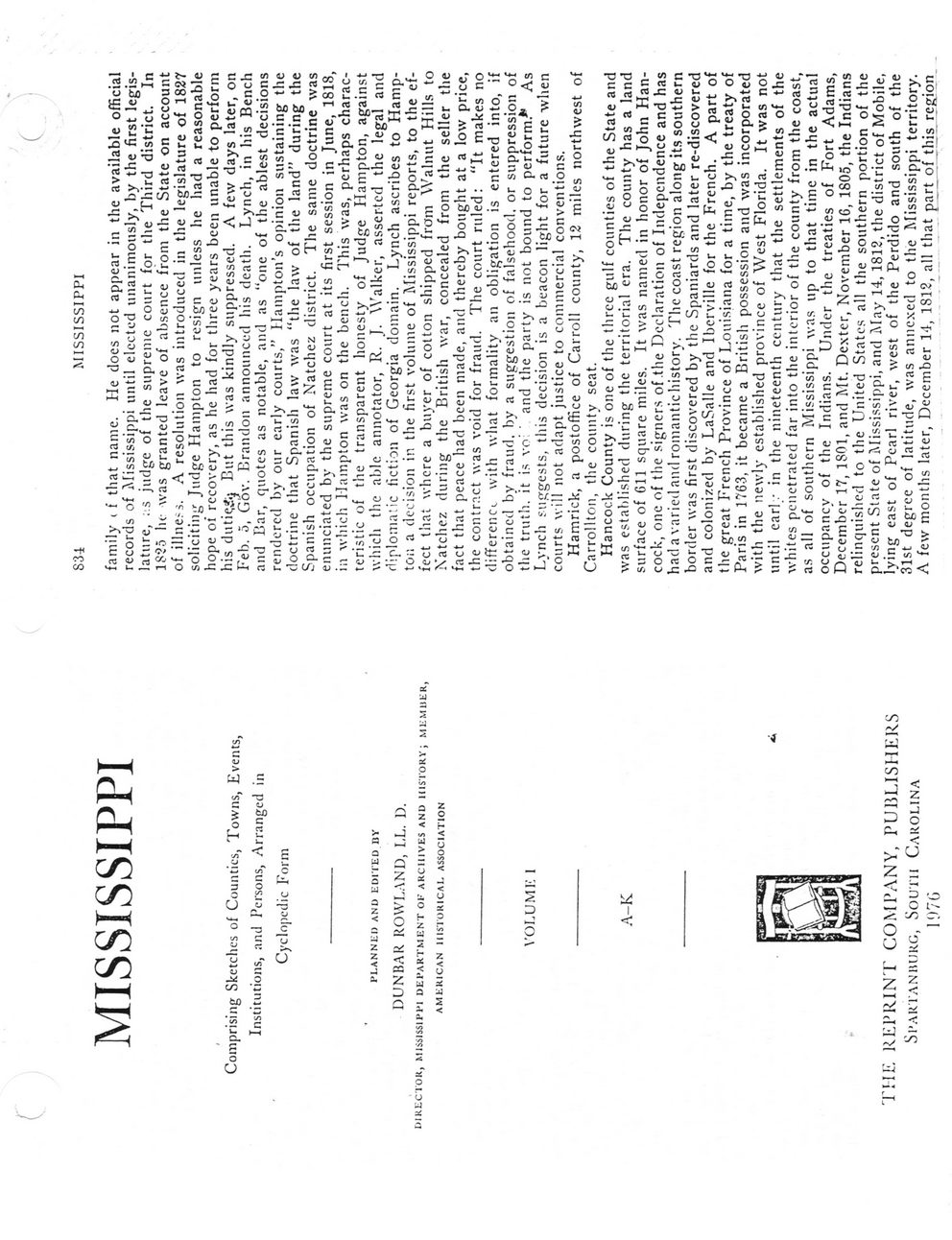This text was obtained via automated optical character recognition.
It has not been edited and may therefore contain several errors.
MISSISSIPPI Comprising Sketches of Counties, Towns, Events, Institutions, and Persons, Arranged in Cyclopedic Form PLANNED AND EDITED BY DUNBAR ROWLAND, I.L. D. DIRECTOR, MISSISSIPPI DEPARTMENT Ol' ARCHIVES AND HISTORY; MEM1IER, AMERICAN HISTORICAL ASSOCIATION VOLUMK 1 A-K THE REPRINT COMPANY, PUBLISHERS S 1‘ARTAN 1UJRG, SOUTH CAROLINA 1 ‘>76 S34 MISSISSIPPI family < f that name. He does not appear in the available official records of Mississippi until elected unanimously, by the first legislature, ;.s judge of the supreme court fpr the Third district. In 1S‘25 lie was granted leave of absence from the State on account of illne.'S. A resolution was introduced in the legislature of 1827 soliciting Judge Hampton to resign unless he had a reasonable hope of recovery, as he had for three years been unable to perform his dutiq&j But this was kindly suppressed. A few days later, on Feb. 5, Gov. Brandon announced his death. Lynch, in his Bench and Bar, quotes as notable, and as “one of the ablest decisions rendered by our early courts,” Hampton’s opinion sustaining the doctrine that Spanish law was “the law of the land” during the Spanish occupation of Natchez district. The same doctrine was enunciated by the supreme court at its first session in June, 1818, in which Hampton was on the bench. This was, perhaps characteristic of the transparent honesty of Judge Hampton, against which the able annotator, R. J. Walker, asserted the legal and diplomatic fiction of Georgia doinain. Lynch ascribes to Hampton a decision in the first volume of Mississippi reports, to the effect that where a buyer of cotton shipped from Walnut Hills to Natchez during the British war, concealed from the seller the fact that peace had been made, and thereby bought at a low price, the contrp.ct was void for fraud. The court ruled: "It makes no difference with what formality an obligation is entered into, if obtained by fraud, by a suggestion of falsehood, or suppression of the truth, it is vo: \ and the party is not bound to perform.** As Lynch suggests, this decision is a beacon light for a future when courts will not adapt justice to commercial conventions. Hamrick, a postoffice of Carroll county, 12 miles northwest of Carrollton, the county seat. Hancock County is one of the three gulf counties of the State and was established during the territorial era. The county has a land surface of Gil square miles. It was named in honor of John Hancock, one of the signers of the Declaration of Independence and has had a varied and romantic history. The coast region along its southern border was first discovered by the Spaniards and later re-discovered and colonized by LaSalle and Iberville for the French. A part of the great French Province of Louisiana for a time, by the treaty of Paris in 1763, it became a British possession and was incorporated with the newly established province of West Florida. It was not until early in the nineteenth century that the settlements of the whites penetrated far into the interior of the county from the coast, as all of southern Mississippi was up to that time in the actual occupancy of the Indians. Under the treaties of Fort Adams, December 17, 1801, and Mt. Dexter, November 16, 1805, the Indians relinquished to the United States all the southern portion of the present State of Mississippi, and May 14,1812, the district of Mobile, lying east of Pearl river, west of the Perdido and south of the 31st degree of latitude, was annexed to the Mississippi territory. A few months later, December 14, 1S12, all that pan of this region.

Kiln History Document (045)